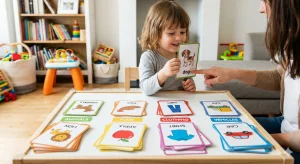Still Face Syndrome: Prevent It by Boosting Emotional Engagement
Last Updated: January 23, 2025
Still Face Syndrome: Ever noticed when a child goes quiet, or maybe even gets a little frustrated, when you’re not paying attention? You might think they’re just in a mood, but it could be a sign of something deeper—emotional disengagement. This could potentially be related to still face syndrome, a condition where children react to a lack of facial expressions or emotional responsiveness from caregivers. Children thrive on emotional connection, and when they feel ignored or overlooked, it can create a gap that affects their development. As parents or caregivers, it’s crucial to understand these signs and take steps to prevent emotional disconnection and address still face syndrome.
What is Still Face Syndrome?
So, what exactly is Still Face Syndrome? It’s a situation where a parent or caregiver becomes emotionally unresponsive during interactions with their child. Imagine you’re playing with your child or talking to them, but then suddenly, your face goes blank, and you stop reacting. No smiles, no responses—just a neutral expression. This lack of engagement can leave a child feeling confused, ignored, and unsure about how to continue the interaction.
Children rely on your emotional responses to feel connected, and when that emotional feedback disappears, it can cause them to feel frustrated or anxious. In some cases, especially if this happens often, children may begin to withdraw, stop trying to engage, or even experience emotional distress. This is why Still Face Syndrome can have a long-lasting impact on a child’s emotional development if not addressed.
Why It Matters
Children need emotional engagement to thrive. When they encounter moments where a parent becomes emotionally unavailable, they can feel isolated. Over time, this lack of connection may make children feel anxious, upset, or even develop feelings of insecurity. If left unchecked, Still Face Syndrome can disrupt their ability to form strong emotional bonds, express their feelings, and develop healthy communication skills.
Addressing these moments of emotional disengagement early can help prevent longer-term issues. As caregivers, being mindful of our reactions and making sure we stay emotionally present can make a world of difference in how children feel about themselves and their relationship with others.
Why Emotional Engagement is Crucial
Building a strong emotional connection with your child is one of the most important things you can do as a parent. It’s not just about keeping them happy in the moment—it’s about helping them feel safe, secure, and loved for the long term. When your child trusts you and feels emotionally connected, it lays the foundation for a healthy, supportive relationship that can last a lifetime.
Building Bonds
Think of emotional engagement as the glue that strengthens your bond with your child. When you respond to their needs, show them affection, and communicate in a way that makes them feel seen, they begin to trust you more deeply. This trust is key to their sense of security. A child who feels emotionally connected to their caregiver knows they have someone they can rely on, which helps them feel confident and safe in their world.
Healthy Growth
Emotional engagement isn’t just about the heart—it’s also crucial for the brain. When children experience consistent emotional connection, it boosts their brain development, particularly in areas that control emotional regulation and social skills. Through your interactions, they learn how to express their feelings, manage their emotions, and navigate relationships. Essentially, the way you engage with your child teaches them how to connect with others, laying the groundwork for healthy emotional habits throughout their life.
Also Read: Fun 7 Activities to Boost Emotional Regulation in Young Children
5. Easy Ways to Boost Emotional Engagement
Building emotional connections with your child doesn’t have to be complicated. It’s often the little things that make the biggest difference. Here are some simple but powerful ways to strengthen your emotional bond with your child:
1. Be Present
Your child craves your full attention, even if it’s just for a few minutes at a time. Put away distractions like your phone or TV and focus entirely on them during these moments. When you’re truly present, your child feels valued and heard, which boosts their sense of security. Remember, it’s not about the length of time but the quality of the interaction.
2. Respond to Cues
Children often send out signals when they want your attention. It could be a smile, a question, or even a simple look in your direction. Responding to these cues by smiling back, engaging in conversation, or showing them that their emotions matter to you, can greatly impact their feelings of connection and understanding. These small gestures make your child feel connected and understood.
3. Play Together
Playtime is more than just fun—it’s a critical opportunity for emotional bonding. Simple activities like playing hide-and-seek, building blocks, or even a silly dance session can help your child feel close to you. During these playful moments, your child is more relaxed and open, which strengthens your relationship and builds trust.
4. Use Facial Expressions
Your child is constantly looking to your face for emotional cues. Making eye contact, smiling, or showing empathy through your expressions helps them feel emotionally connected. Non-verbal communication like this can sometimes speak louder than words, and children are especially tuned in to these signals. So, when you’re with your child, let your face do the talking!
5. Practice Mindful Parenting
Mindfulness means being fully in the moment with your child. When you’re engaged, they can sense it. Avoid thinking about work or other distractions and try to immerse yourself in the interaction. Whether it’s a conversation or just sitting together, being mentally and emotionally present helps build a stronger connection.
How to Prevent Still Face Syndrome
Preventing Still Face Syndrome doesn’t require drastic changes, but small mindful adjustments in how you interact with your child can make a big difference. Here’s how you can avoid those emotionally disconnected moments and keep your child feeling secure and engaged.
1. Don’t Zone Out
It’s easy to get distracted—whether it’s by your phone, a TV show, or just your thoughts. But when you zone out, even for a few minutes, your child can feel the emotional disconnection. This can create a “still face” moment, where your child senses you’re not emotionally present. Make it a habit to stay present during interactions. By actively engaging, even for short periods, you avoid creating that emotional gap.
2. Keep it Consistent
Consistency is key when it comes to emotional engagement. Children thrive on predictability, especially when it comes to your reactions. If your responses are warm and consistent, they’ll feel secure knowing what to expect from you. Whether it’s a smile, a hug, or a few kind words, maintaining these consistent emotional cues helps prevent the disconnection that leads to Still Face Syndrome.
3. Positive Responses
Always respond positively when your child expresses themselves, even if they’re sharing something small or simple. Acknowledge their efforts with praise or encouragement. By positively reinforcing their emotional outreach, you’re telling them that their feelings matter. This encourages more emotional expression and helps avoid frustration, a key factor in preventing emotional disengagement.
4. Watch for Warning Signs
Your child may show signs of frustration or emotional withdrawal if they start feeling disconnected. Common signals include quietness, a shift in mood, or a lack of interaction. If you notice these signs, it’s important to re-engage quickly. Simple actions like making eye contact, offering a reassuring smile, or starting a playful conversation can make your child feel emotionally connected again and help avoid Still Face Syndrome.
Read more: 5 Early Signs of Still Face Syndrome You Need to Know
Signs of Emotional Engagement vs. Disengagement
| Emotional Engagement | Emotional Disengagement |
|---|---|
| Smiling and Making Eye Contact: Your child smiles and makes eye contact with you, showing they are fully engaged and connected emotionally. | Quiet or Withdrawn Behavior: Your child is unusually quiet, avoids eye contact, or withdraws from interaction, signaling disconnection. |
| Actively Playing or Engaging in Activities: Your child participates in activities, asks to play, or responds excitedly to interaction, showing interest and emotional involvement. | Avoiding Interaction or Looking Away: Your child may turn away or show a lack of interest in activities they usually enjoy, indicating emotional detachment. |
| Asking Questions and Showing Curiosity: They frequently ask questions, show curiosity about their surroundings, or seek your input, indicating that they feel safe and connected to you. | Showing Frustration or Disengagement: Your child may become easily frustrated or show signs of disinterest, which can happen when they feel emotionally disconnected. |
| Seeking Physical or Verbal Interaction: Your child actively seeks hugs, holds your hand, talks to you, or makes verbal requests for your attention, signaling emotional closeness. | Lack of Interest in Responding or Playing: They might stop responding to your prompts or show no interest in playing, indicating a sense of emotional distance. |
Quick Tips for Parents
Parenting is full of busy moments, but making small, intentional efforts to emotionally connect with your child every day can go a long way. Here are a few quick and easy tips to help you maintain that crucial bond with your child:
1. Create Playtime
It’s easy to get caught up in daily tasks, but setting aside even just a few minutes each day for undistracted play with your child can make a world of difference. Whether it’s playing a simple game, reading together, or just laughing and being silly, this dedicated time shows your child they have your full attention. These moments are crucial for building emotional connections and can greatly reduce the chances of emotional disengagement.
2. Limit Screen Time
In today’s digital age, screens are everywhere, but too much screen time can create barriers between you and your child. It’s important to balance screen use with quality face-to-face interactions. Make time for activities that involve direct communication, like talking, playing, or even cooking together. By reducing screen distractions, you’re creating more opportunities for meaningful connection and preventing the Still Face Syndrome effect that often comes from passive screen consumption.
3. Encourage Emotions
Children need to know that expressing their feelings—whether they’re happy, sad, or frustrated—is okay. Encourage your child to talk about their emotions openly, and listen without judgment. When they feel safe expressing themselves, they’re more likely to develop strong emotional skills. Positive reinforcement, like validating their feelings and offering comfort, helps build emotional resilience and deepens your connection with your child.
Conclusion
Emotional engagement is the key to preventing Still Face Syndrome and helping your child grow emotionally strong. By staying present, responding to your child’s needs, and being involved in their daily interactions, you create a bond that helps them feel safe and secure. These small moments of connection help your child develop emotional resilience and the ability to express their feelings in a healthy way.
Now is the time to put these simple tips into practice. Whether it’s setting aside time to play, responding to their emotional cues, or just being more mindful of your reactions, each action strengthens your bond. At Wellness Hub, we’re here to support you on this journey. Check out our resources for more tips on parenting and emotional well-being, and start boosting your child’s emotional connection today!
Frequently Asked Questions:
1. What is Still Face Syndrome in children?
Still Face Syndrome occurs when a caregiver becomes unresponsive during interactions with a child, leaving them feeling ignored or disconnected. This emotional disconnection can lead to frustration and anxiety in children if it happens frequently.
2. Why is emotional engagement important for my child’s development?
Emotional engagement helps children feel safe, secure, and understood. It promotes healthy brain development, emotional resilience, and social skills, ensuring that your child can express and manage their emotions in a healthy way.
3. How can I prevent Still Face Syndrome?
To prevent Still Face Syndrome, focus on being present during interactions with your child. Respond consistently to their emotional cues, provide positive reinforcement, and engage in regular face-to-face interactions, such as playtime or simple conversations.
4. What are the signs of emotional disengagement in children?
Signs of emotional disengagement may include a sudden quietness, frustration, or a lack of interaction from your child. If your child seems disconnected or unresponsive, it’s important to re-engage quickly by showing affection, making eye contact, or playing with them.
5. How can I boost emotional engagement with my child?
You can boost emotional engagement by spending undistracted time with your child, responding to their emotions, and using non-verbal cues like eye contact and facial expressions. Playing together and encouraging emotional expression also help strengthen your bond.
6. How does limiting screen time help with emotional engagement?
Limiting screen time allows for more face-to-face interaction between you and your child. Too much screen time can create barriers to emotional connection, while direct engagement helps build trust and strengthens emotional bonds.
7. What are some quick tips to improve emotional connection with my child?
Quick tips include creating daily playtime without distractions, encouraging your child to express their feelings, and responding positively when they reach out for your attention. Consistent emotional responses also help maintain a strong connection.
8. Can Still Face Syndrome have long-term effects on my child?
Yes, if a child experiences frequent emotional disengagement, it can lead to long-term effects such as anxiety, difficulty forming strong emotional bonds, or challenges in expressing their feelings. Consistent emotional engagement can help prevent these issues.
9. How can I create daily emotional engagement with my child?
To create daily emotional engagement, spend even short but meaningful time with your child. Activities like playing together, talking about their day, or simply listening to their thoughts can make a big difference in strengthening your emotional bond.
10. What should I do if my child seems emotionally withdrawn?
If your child seems emotionally withdrawn, try to re-engage by offering affection, listening to their feelings, or participating in activities they enjoy. Being present and responsive to their emotional needs can help bring them back into connection and prevent further disengagement.
About Author:
Lasya Vooturi,
Clinical Psychologist (A) & Behavioral Therapist
Lasya holds a Professional Diploma in Clinical Psychology from Amity University, where she deepened her understanding of psychological principles from March 2023 to March 2024. With over a year of dedicated experience as a Behavioral Therapist, Lasya has honed her skills in applying effective therapy techniques tailored to individual needs. Fluent in Telugu, Hindi, and English, she is adept at connecting with a diverse range of clients, ensuring comprehensive communication and understanding. Lasya’s approach is grounded in empathy and scientific rigor, making her a trusted ally in navigating mental health challenges.
Book your Free Consultation Today
Parent/Caregiver Info:
Client’s Details:
* Error Message









